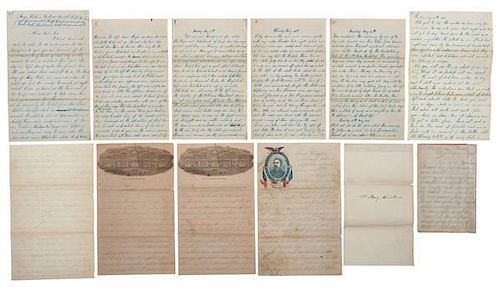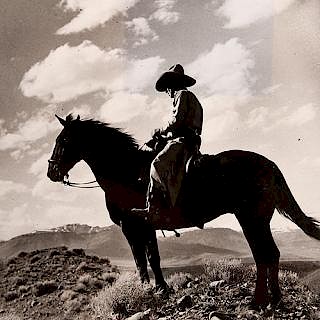George S. Youngs, 126th New York Volunteers, POW Harper's Ferry, Civil War Archive
About Seller
6270 Este Ave.
Cincinnati , OH 45232
United States
With offices in Cincinnati, Cleveland and Denver, Cowan’s holds over 40 auctions each year, with annual sales exceeding $16M. We reach buyers around the globe, and take pride in our reputation for integrity, customer service and great results. A full-service house, Cowan’s Auctions specializes in Am...Read more
Two ways to bid:
- Leave a max absentee bid and the platform will bid on your behalf up to your maximum bid during the live auction.
- Bid live during the auction and your bids will be submitted real-time to the auctioneer.
Bid Increments
| Price | Bid Increment |
|---|---|
| $0 | $25 |
| $500 | $50 |
| $1,000 | $100 |
| $2,000 | $250 |
| $5,000 | $500 |
| $10,000 | $1,000 |
| $20,000 | $2,500 |
| $50,000 | $5,000 |
| $100,000 | $10,000 |
About Auction
Jun 12, 2015 - Jun 13, 2015
Cowan's Auctions dawnie@cowans.com
- Lot Description
Lot of over 250 Civil War-era letters to and from George S. Youngs and his mother, brother, and sister (approx. 135 are from Youngs to his family); 4 Civil War CDVs, incl. unmarked view of Gouverneur K. Warren as brig. general, Fredricks & Co. view of captain, unmarked carte of 2nd lieutenant, and unmarked carte of a young sergeant; and several religious tracts and newspaper clippings. Ca September 1862 to the end of the war.
George S. Youngs was born in 1843 to James and Effie Youngs at Waterloo, Seneca County, NY. He enlisted for three years at Waterloo on August 15, 1862, as a private and was mustered into G Company of the New York 126th Infantry on August 22 of that same year. At the time of his enlistment, he was a 19-year-old carpenter living at home. Youngs was taken prisoner at the Battle of Harper’s Ferry, September 15, 1862, but was paroled on the following day as Stonewall Jackson withdrew to rejoin Lee at Antietam/Sharpsburg.
Youngs served with the 126th Infantry throughout the war and saw action in many of the most prominent battles of the war. He was promoted to corporal in February of 1865 and was mustered out on June 3, 1865, at Alexandria, VA. Youngs survived the war and returned to Waterloo where he resumed his work as a carpenter. He later married and he and his wife Hattie lived to the end of their lives in the vicinity of Cleveland, OH. He lived to be 79 and was finally laid to rest in Maple Grove Cemetery in Waterloo after his death in 1922.
On July 15, 1862, Colonel Eliakim Sherrill received authority to raise a regiment in Ontario, Seneca Hand and Yates counties in upstate New York. The NY 126th Infantry was organized at Geneva, and mustered into service of the Union for three years, August 22, 1862.
The regiment left New York on August 26, 1862, and took part in its first fighting during the siege of Harper's Ferry. It received the brunt of the enemy attack and suffered a large share of the casualties. The men of the 126th were part of the 12,400 prisoners of war surrendered on September 15. The men were immediately paroled and spent three months at Camp Douglas in Chicago, IL, awaiting notice of exchange. As soon as notice was received in December, the unit returned to Union Mills, VA. The regiment went on to take part in Gettysburg, Auburn Ford, Bristoe Station, Wilderness, Po River, Spotsylvania, North Anna, Totopotomy, Cold Harbor, Petersburg, Weldon Railroad, siege of Petersburg, Deep Bottom, Hatcher's Run, Boydton Road, Farmville and Appomattox. The regiment was mustered out at Alexandria, VA, June 3, 1865. At Gettysburg, the 126th lost over 15 percent of its men and the total casualties were 57 percent for the war.
The NY 126th was a critical part of the battle of Gettysburg. Situated between the Copse of Trees and Ziegler’s Grove on Cemetery Ridge, they were a significant element in repelling Pickett’s Charge, fending off Trimble and Pettigrew’s forces. Colonel Sherrill was killed in this battle. Today a monument stands in their honor at the site of the battle.
Although the archive does not include letters regarding Youngs’ participation at Gettysburg, it does feature several fine accounts of his experiences at The Wilderness and Spotsylvania. While this may not be a complete history of Youngs’ Civil War service, it contains many insights into the lives and events of foot soldiers caught up in the terrible conflict.
Young’s journey begins with a letter to his sister Louisa upon his arrival at Harper’s Ferry, August 29, 1862; We have arrived here safely...but …we are right amongst the Rebels…camped on the same ground from which Banks was driven by Stonewall Jackson…Last night we saw a flashing over in the valley south of us which the boys who had seen service said was cannon… in less than two weeks he would become very well acquainted with both Stonewall Jackson and cannon fire.
On September 30, 1862, he is writing to his sister about the battle at Harper’s Ferry; …the shells were flying over our heads so close that we would instinctively lay our heads close to the ground. They sang an uglier tune than the bullets did the day before….The reb’s planting several other batteries the night and in the morning they opened fire on us from every direction. In Co. B…there were seven men killed with one shell and that without bursting…It drove one man’s canteen right through his body and took the top of another man’s head off and killed two more instantly…About nine o’clock General White surrendered to Jackson…The Rebels treated us like men in every way. Indeed the boys generously acknowledged that we received much better treatment at their hands than they would have received at ours….I exchanged canteens with a member of the first South Carolina Rifles. He also cut a palmetto button off his coat for me.
Camped in Virginia in January 1863, he writes to his sister about the persistent threat of disease- a peril that at least equaled battle: There were two men shot on picket night before last. One was killed the other was wounded through the calf of the leg. Such occurrences that do not excite the comments of the men one fourth as much as death from disease which has become a daily or nightly occurrence. Last week 11 men died from our regiment…
Again camped in Virginia in August 1863, we get an insight into the erosion of the Southern way of life and economy. Youngs talks about the unit getting milk from a plantation owner named Mr. Spilger: He has 200 acres of land and has been raising large crops of wheat and corn but I am afraid he will not raise more than enough for his own use. He has not the [slaves] to do even that now. The last he had, nine in number, left him night before last. The old man was nearly crazy the next morning…wishing that he had sent the [slaves] down south or put a ball through “that Simon” whom he blamed for the whole of it.
In May 1864, Youngs writes a 22pp account of two weeks of battle at The Wilderness and Spotsylvania Courthouse to his sister Louisa: May 5th--Got up and got breakfast at four o’clock...we are moving in what seems to be an almost impenetrable Wilderness…Gregg and Stuarts Cavalry have had a pretty sharp fight and skedaddlers report that Gregg has been driven badly…Shortly after we got here a heavy musketry fire commenced and quickly grew into one awful and continuous roar…the wounded are coming to the rear in great numbers. The fight continued with unabated fury ‘til after dark. General Hays is reported killed. May 6th—Soon after daylight the fight opened again and soon grew as heavy as it was last night…James Holenbeck was brought in on a stretcher pretty badly wounded. The ball entered his side and passed nearly through the opposite side…I had some interesting conversation with some of [the Rebel prisoners]. One of them says that Gen. Longstreet is wounded… Another prisoner…openly avows that he came [across] intentionally. He was conscripted and taken from Fredricksburg where he left a wife and children only a week ago…The woods have been on fire on all sides of us today and a great many of the wounded have probably been burned to death. —The Rebs threw a few shells over this way …General Hancock rode up and ordered Major Bull to support Arnold’s Battery…we seem to be moving on a road parallel with the enemy and are fighting with them every day. May 9th—Generals Grant and Meade passed here in company about ten o’clock…the troops are all moving to the left again in the direction of Spotsylvania Courthouse…May 10th –Evening. A most desperate fight has been in progress since noon. Our Forces have been driven back some on the right. Several charges have been made on both sides and the loss must be very heavy. May 12th – [Arose] at one o’clock …the boys say that the Rebels threw two or three shells pretty close to us. They failed to wake me…we moved off at about two…[and] halted just at day light …immediately charged the Rebel works capturing over two thousand men, one major General (Johnson) and two Brigadiers…afterward the road was lined with the wounded, a good many of them dying …The hardest fighting of the whole eight days has been done today. The cannonading has been very heavy and constant. The slaughter has been terrible. May 14th --The burial parties have been sent out on the field to bury the dead. Persons who have been out there say that it is the most horrible sight they ever witnessed and they were at Gettysburg. May 16th—Went up by the Amputating table of the 8th Corps Hospital this morning. Legs and arms lay around as casually as chips around a carpenter’s bench. May 18th --Another grand charge has been made by our forces this morning and from all accounts of the wounded, our loss has been fearful…. The men were literally mown down by grape and canister. May 20th—All quiet today. The weather has been very fine and warm…The attack on our flank last night was made by two divisions of Ewell’s corps…but they were repulsed…Thank God I am still alive and in excellent health and hoping this may find you the same.All are hand written in ink or pencil. Nearly all are signed and dated. Paper sizes and the number of pages per letter vary. Letters are written front and back and contain multiple pages. Condition varies from faded to very good. Many stamped envelopes are included.Condition
- Shipping Info
-
SHIPPING. At the request of the buyer, Cowan's will authorize the shipment of purchased items. Shipments usually occur within two weeks after payment has been received. Shipment is generally made via UPS Ground service. Unless buyer gives special instructions, the shipping method shall be at the sole discretion of Cowan's Auctions, Inc.. Cowan's is in no way responsible for the acts or omissions of independent handlers, packers or shippers of purchased items or for any loss, damage or delay from the packing or shipping of any property.
-
- Buyer's Premium



 EUR
EUR CAD
CAD AUD
AUD GBP
GBP MXN
MXN HKD
HKD CNY
CNY MYR
MYR SEK
SEK SGD
SGD CHF
CHF THB
THB













